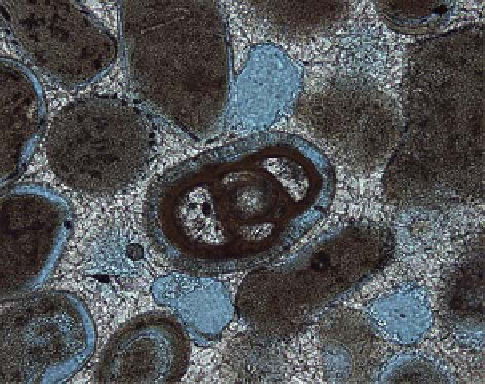Geology Reference
In-Depth Information
Fig. 14.
Radially coated ooid from Late Pleistocene oolite
at Boiling Hole (sample EL 204). Radial cortex suggests that
ooid formation occurred in a relatively low-energy setting.
Sample location is indicated in Fig. 13.
Fig. 13.
Stratigraphic/sedimentological section logged on
the southeastern end of the Boiling Hole site. In the setting
column, s = subtidal, b = beach, e = aeolian. Dots indicate
sample location. 204 marks the location of sample EL 204
illustrated in Fig. 14.
lasted long enough for the shoreline to prograde
signifi cantly towards the southwest.
CONCLUSIONS
Further, as already noted by Kindler & Hearty
(1995), the MIS 5e deposits include some peculiar
ooids with a radial cortex (Fig. 14).
The dip of the beach beds clearly shows that
the constituent grains of these sediments origin-
ated from the interior of the bank, to the south-
west. The eolian strata dip in the same direction.
However they are not foresets, as suggested by ear-
lier authors (Kindler & Hearty, 1995; Hearty, 1998),
but backsets draped over the pre-existing middle
Pleistocene topography. Thus, their component
particles were also brought up from the bank inter-
ior by a westerly fl ux, and not from the open ocean
by the prevailing easterly winds, as previously
interpreted. Further, the unusual occurrence of
radial ooids (Fig. 14) in these deposits suggests
a relatively low-energy production locus (Land
et al.
, 1979; Flügel, 2004), thus strengthening a
bank-side source for these deposits. The case is
even clearer at Cotton Hole, 1 km to the northwest
(Fig. 11), where bankward-dipping beach sedi-
ments exposed on the ocean-facing cliffs can be
walked on all the way to the bank-facing shoreline
of the island. The Boiling Hole outcrop thus valid-
ates the fourth model. Moreover, ooids were not
carried eastward during a single and catastrophic
depositional event, such as a storm or a north-
westerly gale, but by a sustained westerly fl ux that
The response to Ginsburg's question about the
curious occurrence of large oolite accumulations
on the windward islands of GBB is the follow-
ing. Most likely, ooids have been produced on
a very narrow outer platform between the bank
edge and the islands, as is the case today along
the Yucatan Peninsula (Ward & Brady, 1979), and
were brought onto the islands by transport vec-
tors (i.e. wind and waves) similar in orientation
to those operating today. This model is supported
by theoretical calculations. In addition, ooids may
have been generated on a wide outer platform that
has since disappeared due to recessive erosion. In
some cases, for example the Boiling Hole area in
Eleuthera, ooids have been formed on the bank
side and transported by energy fl uxes that were
opposite to modern fl uxes. The important point to
consider from this 'ooid story', in particular from
the fourth model, is that past sedimentary features
may not necessarily be explained by the observa-
tion of modern processes, or in other words, that
the present is not always a key to the past.
ACKNOWLEDGEMENTS
PK would like to thank again R.N. Ginsburg for
accepting him as a post-doctoral student in his



























































































